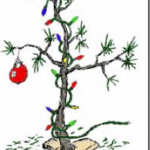 My family likes a good Charlie Brown tree. The wimpier, the better. Every year we approach the lot looking for the tree that leans over the most, with the fewest branches to hold our cache of macaroni ornaments. We don’t like it, however, when it drops it needles before the guy in the suit shows up.
My family likes a good Charlie Brown tree. The wimpier, the better. Every year we approach the lot looking for the tree that leans over the most, with the fewest branches to hold our cache of macaroni ornaments. We don’t like it, however, when it drops it needles before the guy in the suit shows up.
The Christmas tree business is huge, especially in Atlantic Canada. To the tune of $70M/year, Christmas tree growers are anxious to have their product last as long as possible. Unfortunately, too many trees drop their needles before they’re sold, often en route to the big markets in the U.S. This is bad news for the small tree lot owners. Scientists at the (wait for it…) the Christmas Tree Research Centre recently developed a smart tree that will hold its needles for twice as long. This is great news for consumers and producers alike. Consumers get a tree that lasts longer and producers have their problem of perishability reduced. New product development is an important aspect of marketing: recognizing a problem, either consumer or producer, in this case both, and solving it in an innovative way.
How’d the Christmas Tree Research Centre solve it? By feeding the trees hormones! The same hormones that cause bananas to ripen and go bad apparently keep the needles on the branches, allowing your pipe cleaner decorations to swing merrily for a few more days…and your Charlie Brown tree to continue on being Charlie Brown for a little longer.
